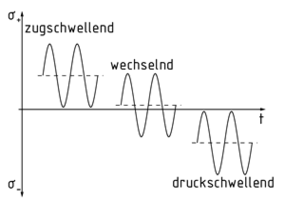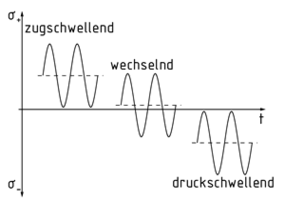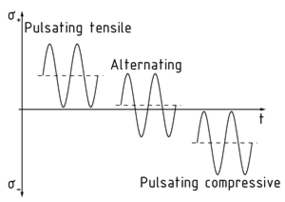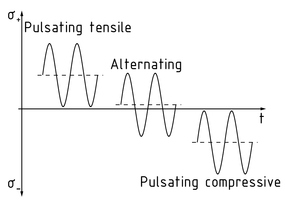
一种定义
四种语言
0,1,2
- 德國
- 英語
- 中國
- 西班牙語
交变应力

在交变应力情况下,构件上的应力随时间周期性变化,且应力的方向随时间交替变化。最大应力 ${{\sigma }_{o}}$ 与最小应力 ${{\sigma }_{u}}$ 的方向彼此相反。
最小应力与最大应力之比可以得出交变应力的循环特征 $R=\frac{{{\sigma }_{u}}}{{{\sigma }_{o}}}$ 。平均应力 ${{\sigma }_{m}}$ 是最大应力和最小应力的平均值。根据上述定义,下列不同条件下力的效果不同:
${{\sigma }_{m}}<0$ :
如果最大应力和最小应力都为负方向,则力的效果为脉动压应力。
如果最大应力等于零而最小应力为负方向,则力的效果为纯脉动压缩应力。
如果最大应力和最小应力方向相反且大小不等,则力的效果为交变应力。
${{\sigma }_{m}}=0$ :这种情况下力的效果为交变应力。
${{\sigma }_{m}}>0$ :
如果最大应力和最小应力方向相反且大小不等,则力的效果为交变应力。
如果最小应力等于零而最大应力为正方向,则力的效果为纯脉动拉伸应力。
如果最大应力和最小应力都为正方向,则力的效果为脉动拉伸应力。
交变应力/脉动应力的应力图
Wechselbeanspruchung

Bei der Wechselbeanspruchung wirken Kräfte zyklisch und mit einer Richtungsänderung auf ein Bauteil. Dies ist der Fall, wenn die größte auftretende Spannung, die sogenannte Oberspannung${{\sigma }_{o}}$, gegensätzlich zu der kleinsten auftretenden Spannung, der Unterspannung${{\sigma }_{u}}$, gerichtet ist.
Der Quotient aus Unter- und Oberspannung ergibt das sogenannte Spannungsverhältnis $R=\frac{{{\sigma }_{u}}}{{{\sigma }_{o}}}$. Die sogenannte Mittelspannung ${{\sigma }_{m}}$ist der Mittelwert aus Ober- und Unterspannung. Abhängig von dieser werden folgende Fälle unterschieden:
${{\sigma }_{m}}<0:$
- Sind Ober- und Unterspannung jeweils negativ, so liegt eine Druckschwellbeanspruchung vor.
- Ist die Oberspannung gleich null und die Unterspannung negativ, liegt eine reine Druckschwellbeanspruchung vor.
- Sind Ober- und Unterspannung gegensätzlich gerichtet und betragsmäßig ungleich, liegt eine Wechselbeanspruchung vor.
${{\sigma }_{m}}=0$: Es liegt eine reine Wechselbeanspruchung vor.
${{\sigma }_{m}}>0:$
- Sind Ober- und Unterspannung gegensätzlich gerichtet und betragsmäßig ungleich, so liegt eine Wechselbeanspruchung vor.
- Ist die Unterspannung gleich null und die Oberspannung positiv, liegt eine reine Zugschwellbeanspruchung vor.
- Sind Ober- und Unterspannung jeweils positiv, so liegt eine Zugschwellbeanspruchung vor.
Alternating stress

In the case of alternating stress, cyclic forces act on a component with a change of direction. This is the situation when the maximum stress${{\sigma }_{o}}$ is in the opposite direction to the minimum stress${{\sigma }_{u}}$.
Dividing the minimum stress by the maximum stress gives the stress ratio $R=\frac{{{\sigma }_{u}}}{{{\sigma }_{o}}}$. The mean stress ${{\sigma }_{m}}$is the average stress calculated using the maximum and minimum values. Based on this, a distinction is made between the following scenarios:
${{\sigma }_{m}}<0:$
- If the maximum and minimum stresses are both negative, the result is a pulsating compressive stress.
- If the maximum stress equals zero and the minimum stress is negative, the result is a pure pulsating compressive stress.
- If the maximum and minimum stresses act in opposite directions and are not equal, the result is an alternating stress.
${{\sigma }_{m}}=0$: This indicates a pure alternating stress.
${{\sigma }_{m}}>0:$
- If the maximum and minimum stresses act in opposite directions and are not equal, the result is an alternating stress.
- If the minimum stress equals zero and the maximum stress is positive, the result is a pure pulsating tensile stress.
- If the maximum and minimum stresses are both positive, the result is a pulsating tensile stress.
Esfuerzo alternante

En el caso de un esfuerzo alternante, las fuerzas cíclicas actúan en un componente con un cambio de dirección. Esta es la situación cuando el esfuerzo máximo ${{\sigma }_{o}}$ está en la dirección opuesta al esfuerzo mínimo ${{\sigma }_{u}}$ .
Dividir el esfuerzo mínimo por el esfuerzo máximo da como resultado la relación de esfuerzos $R=\frac{{{\sigma }_{u}}}{{{\sigma }_{o}}}$ . El esfuerzo medio ${{\sigma }_{m}}$ es el esfuerzo promedio calculado usando los valores mínimos y máximos. Basado en esto, se distingue entre los siguientes escenarios:
${{\sigma }_{m}}<0 $ :
Si los esfuerzos máximos y mínimos son ambos negativos, el resultado es un esfuerzo de compresión pulsante.
Si el esfuerzo máximo es igual a cero y el esfuerzo mínimo es negativo, el resultado es un esfuerzo de compresión pulsante puro.
Si los esfuerzos mínimos y máximos actúan en direcciones opuestas y no son iguales, el resultado es un esfuerzo alternante.
${{\sigma }_{m}}=0$ : Esto indica un esfuerzo alternante puro.
${{\sigma }_{m}}>0$ :
Si los esfuerzos mínimos y máximos actúan en direcciones opuestas y no son iguales, el resultado es un esfuerzo alternante.
Si el esfuerzo mínimo es igual a cero y el esfuerzo máximo es positivo, el resultado es un esfuerzo de tensión pulsante puro.
Si los esfuerzos máximos y mínimos son ambos positivos, el resultado es un esfuerzo de tensión pulsante.
Perfil de esfuerzo para un esfuerzo alternante/pulsante
